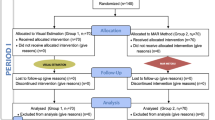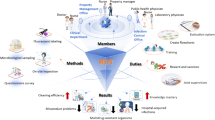Key Points
-
Assembled Siqveland matrix bands are contaminated with blood.
-
Current pre-cleaning methods cannot remove blood from assembled bands.
-
Siqveland matrix bands should be discarded after use on one patient.
-
Blood can be removed from retainers after removal of the matrix band.
-
Immersion in enzymic detergent followed by processing in an instrument washer is the most effective method of pre-cleaning for Siqveland matrix retainers.
Abstract
Objectives This study investigated blood contamination of artificially and clinically contaminated Siqveland matrix bands and retainers. A modified version of the recognised Kastle-Meyer test for blood was used to compare the efficacy of enzymatic agents, a washer-disinfector and an instrument washer for pre-sterilisation cleaning of Siqveland matrix bands and retainers.
Methods Assembled Siqveland matrix bands were contaminated either artificially with horse blood or clinically during dental treatment. Contaminated assembled matrix bands and retainers were subjected to immersion in an enzymatic agent, automated processing in a washer-disinfector or instrument washer, or a combination of pre-soaking and automatic cleaning. Residual blood contamination from each band and retainer was measured and compared to the volume of blood recovered from an unprocessed control group of contaminated assembled matrix bands or retainers.
Results Residual blood was recovered from every clinically contaminated assembled Siqveland matrix band and retainer. The volume of blood recovered from assembled Siqveland matrix bands ranged from 0.13-7.1 μl and from retainers, following removal of the matrix band, from 0.001-1.523 μl. The most effective method of pre-sterilisation cleaning for artificially contaminated assembled matrix bands was processing in the washer-disinfector. Conversely, the most effective method for cleaning clinically contaminated assembled matrix bands and retainers was pre-soaking in an enzymatic agent followed by a heavy-duty cycle in an instrument washer.
Conclusions It is not possible to clean assembled Siqveland matrix bands using any method currently available to dental practitioners. Matrix bands should be discarded after use on one patient. Once the band is removed, all detectable blood can be removed from the retainer by pre-soaking in an enzymatic detergent followed by processing in an instrument washer.
Similar content being viewed by others
Log in or create a free account to read this content
Gain free access to this article, as well as selected content from this journal and more on nature.com
or
References
British Dental Association. Advice sheet A12, Infection control in dentistry. London: BDA, 2003.
Centers for Disease Control and Prevention. Guidelines for infection control in dental health-care settings - 2003. MMWR Recomm Rep 2003; 52 (RR-17): 1–61.
Drescher J, Wagner D, Haverich A et al. Nosocomial hepatitis B virus infections in cardiac transplant recipients transmitted during transvenous endomyocardial biopsy. J Hosp Infect 1994; 26: 81–92.
Dumpis U, Kovalova Z, Jansons J et al. An outbreak of HBV and HCV infection in a paediatric oncology ward: epidemiological investigations and prevention of further spread. J Med Virol 2003; 69: 331–338.
Comstock R D, Mallonee S, Fox J L et al. A large nosocomial outbreak of hepatitis C and hepatitis B among patients receiving pain remediation treatments. Infect Control Hosp Epidemiol 2004; 25: 576–583.
Yerly S, Quadri R, Negro F et al. Nosocomial outbreak of multiple bloodborne viral infections. J Infect Dis 2001; 184: 369–372.
Lowe A H, Burke F T J, McHugh S, Bagg J . A survey of the use of matrix bands and their decontamination in general dental practice. Br Dent J 2002; 192: 40–42.
Lowe A H, Bagg J, Burke F J, MacKenzie D, McHugh S . A study of blood contamination of Siqveland matrix bands. Br Dent J 2002; 192: 43–45.
Glaister J . The Kastle-Meyer test for the detection of blood. Br Med J 1926; 10: 650–652.
Whitworth C L, Martin M V, Gallagher M, Worthington H V . A comparison of decontamination methods used for dental burs. Br Dent J 2004; 197: 635–640.
Fulford M R, Ireland A J, Main B G . Decontamination of tried-in orthodontic molar bands. Eur J Orthod 2003; 25: 621–622.
Edmunds L M, Rawlinson A . The effect of cleaning on blood contamination in the dental surgery following periodontal procedures. Aust Dent J 1998; 43: 349–353.
Statistical package for social sciences for Windows [program]. 11.0.0 version. Chicago: SPSS, 2001.
Miller C . Instrument cleaning involves multiple steps. Dentist 1990; 68: 23–25.
Lee W M . Hepatitis B infection. N Engl J Med 2005; 337: 1733–1745.
Ballard A L, Boxall E H . Assessing the infectivity of hepatitis B carriers. Commun Dis Public Health 1999; 2: 178–183.
Barker L F, Shulman N R, Murray R et al. Transmission of serum hepatitis. J Am Med Assoc 1970; 211: 1509–1512.
Barton P M, M.V. Incidence of occult blood in hospital orthodontic practice. J Dent Res 1995; 74: 887.
McColl E, Bagg J, Winning S . The detection of blood on dental surgery surfaces and equipment following dental hygiene treatment. Br Dent J 1994; 176: 65–67.
Letters S, Smith A J, McHugh S, Bagg J . A study of visual and blood contamination on reprocessed endodontic files from general dental practice. Br Dent J 2005; 199: 522–525.
Macdonald G . Can the thermal disinfector outperform the ultrasonic cleaner? J Am Dent Assoc 1996; 127: 1787–1788.
Sanchez E, Macdonald G . Decontaminating dental instruments: testing the effectiveness of selected methods. J Am Dent Assoc 1995; 126: 359–366.
Kneedler J A, Darling M H . Using an enzymatic detergent to prerinse instruments. A research study. AORN J 1990; 51: 1326–1332.
Miller C . Cleaning, sterilization and disinfection: basics of microbial killing for infection control. J Am Dent Assoc 1993; 124: 48–56.
Bettner M D, Beiswanger M A, Miller C H, Palenik C J . Effect of ultrasonic cleaning on microorganisms. Am J Dent 1998; 11: 185–188.
Acknowledgements
The authors would like to thank the British Dental Association Shirley Glasstone Hughes Memorial Prize fund for supporting this project.
Author information
Authors and Affiliations
Corresponding author
Additional information
Refereed Paper
Rights and permissions
About this article
Cite this article
Whitworth, C., Davies, K., Palmer, N. et al. An investigation of the decontamination of Siqveland matrix bands. Br Dent J 202, E12 (2007). https://doi.org/10.1038/bdj.2007.142
Accepted:
Published:
Issue date:
DOI: https://doi.org/10.1038/bdj.2007.142
This article is cited by
-
The cleaning of photographic retractors; a survey, clinical and laboratory study
British Dental Journal (2010)
-
Decontamination of Siqveland matrix bands
British Dental Journal (2007)
-
Cleanability of dental instruments – implications of residual protein and risks from Creutzfeldt-Jakob disease
British Dental Journal (2007)



